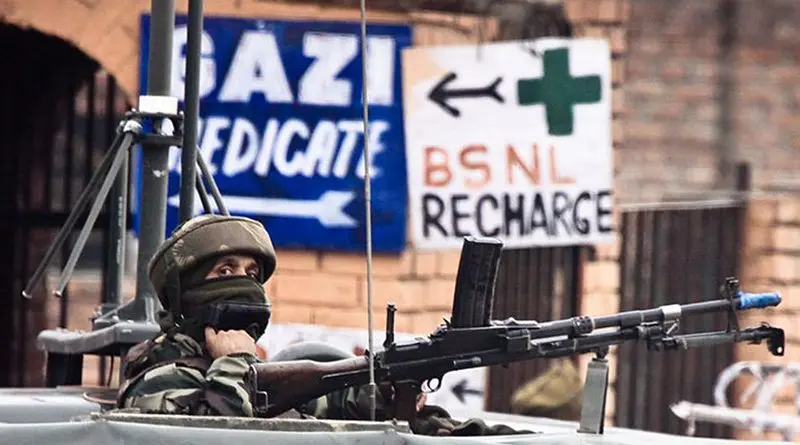Indian Kashmir Sees Bloodiest Year In Almost A Decade Of Battling Insurgents
By BenarNews
By Amin Masoodi
Counter-insurgency operations in 2017 killed more than 340 people in Indian Kashmir, including suspected militants, security personnel and civilians, making it the bloodiest year in nearly a decade for the disputed Himalayan territory, a top security official said.
Indian security forces claimed to have gunned down more than 210 militants, and 54 civilians and 78 security personnel also lost their lives during anti-militant operations. This year’s death toll was the highest since 2010, when more than 380 people, including about 110 civilians and 270 suspected militants, were killed in such operations, police said.
“[The year] 2017 was a mix of challenges and successes. We were able to eliminate some top militants of Pakistan-based Lashkar-e-Taiba (LeT) and Jaish-e-Muhammad (JeM), but in the process lost a large number of civilian and non-civilian lives,” Ravideep Sahi, the inspector general of the paramilitary Central Reserve Police Force (CRPF) in Indian Kashmir, told BenarNews.
The new year will prove to be another challenge for Indian forces as some 275 militants, including at least 150 LeT and JeM cadres, are still active in the territory, Sahi said.
Kashmir, home to a separatist insurgency for decades, is claimed in its entirety by both India and Pakistan, but each country controls only part of it. More than 70,000 people have died in flare-ups of insurgency-related violence since the late 1980s, officials said.
“Despite repeated warnings and appeals to stay away from areas where firing is going on, civilians continue to congregate and protest at encounter sites, eventually getting killed in cross-fire,” Sahi said.
In 2016, about 325 people, including protesters and suspected insurgents, died in months of unrest, officials said.
Shot point-blank
Locals alleged that a large number of civilian deaths this year resulted from cold-blooded killings at the hands of Indian security forces, who are routinely accused of committing rights abuses in the Muslim-majority region.
“There was an exchange of fire going on between Indian forces and militants. My wife was passing by the site when one soldier shot her in the head from point-blank range. Our 7-month-old child is now left without a mother,” Ishfaq Ahmad, 22, told BenarNews.
Ahmad’s wife, Maysara Akther, 20, was one of two civilian women killed during a counter-insurgency operation in north Kashmir’s Kupwara district earlier this month.
On Monday, Indian forces gunned down Noor Mohammad Tantray, a top JeM cadre, in an encounter in Srinagar.
“His killing is a major success for us, as he was involved in major anti-India operations in Kashmir over the past 10 years,” Sahi said, referring to Tantray.
The good part of the year gone by, Sahi said, was that there was a “drastic decline” in incidents of stone-throwing by Kashmiri protesters during anti-India rallies.
“Also, a large number of Kashmiri youths, who had been pulled into militancy, gave up their firearms and surrendered to start a fresh life,” he said.
Line of Control
Two of three full-blown wars fought by Pakistan and India – in 1947 and 1965 – have been over Kashmir, which is divided between the two sides by a de facto border called the Line of Control (LoC). The two nuclear-armed rivals routinely accuse each other of ceasefire violations and harboring terrorism.
On Monday, the Indian Army claimed to have crossed the LoC and killed three Pakistani soldiers to retaliate against a cross-border attack by the Pakistan Army that killed four Indian soldiers on Saturday.
There were more than 300 infiltration attempts by Pakistan-sponsored militants to cross the LoC into Indian Kashmir, the highest in four years, India’s Ministry of Home Affairs said, adding that 2017 also witnessed a major spike in ceasefire violations by the neighboring country.
“[Until] Dec. 15, there were 820 ceasefire violations along the LoC in comparison to 228 such violations in 2016 and 153 in 2013. There were more than 310 infiltration attempts by Pakistani militants [in 2017],” Kiren Rijiju, India’s Deputy Minister for Home Affairs, said according to The Hindu newspaper.
“The considerable increase in ceasefire violations and infiltration attempts indicates Pakistan is desperate to push militants into Indian territory,” Rijiju said.
But the Pakistani foreign ministry said Indian security forces fired their guns across the LoC to provide cover for unidentified “non-state actors” – or armed fighters who are not Indian soldiers – who placed improvised bombs that killed the three Pakistani soldiers on Monday.
“The false claims by India about the alleged cross LoC adventures are a figment of their imagination and counter-productive for peace and tranquility on the LoC,” the ministry said in a statement.

